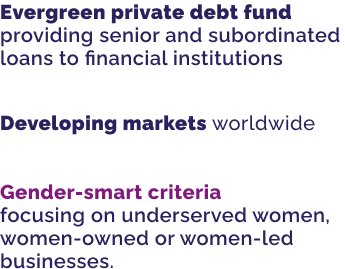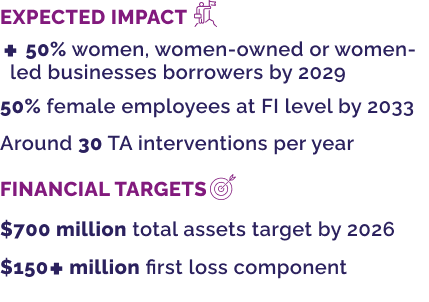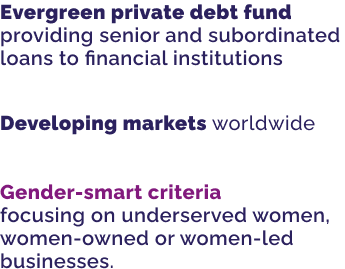Addressing the $1.7 trillion gender gap
through financial inclusion.
Women-owned and women-led SMEs face a $1.7 trillion finance gap globally. This lack of access, combined with underrepresentation of women in finance, limits their economic potential and broader societal impact. Financial institutions miss out on $700 billion in potential revenues by failing to adequately serve this market.
The GGSF, a $500 million blended finance fund, addresses the funding gap faced by underserved women and women-led business in developing markets. Through gender-smart financial services and technical support, it promotes livelihoods, gender equality, and women's leadership.
Mission
The GGSF, a $500 million blended finance fund, addresses the funding gap faced by underserved women and women-led business in developing markets. Through gender-smart financial services and technical support, it promotes livelihoods, gender equality, and women's leadership.

Why does it matter
Since its launch in February 2009, the Fund has played a pivotal role in driving economic development in emerging markets by providing development finance to micro-enterprises and low-income households through partner financial intermediaries (PFIs). Reflecting the dynamic changes in the microfinance sector, the Fund enhanced its mission from the 1st of January 2024, with a renewed focus on gender-smart financial services.
Our impact
Latest quarter - Q4 2023
Latest quarter - Q4 2023
USD 484 M
Loan portfolio
45
Countries
132
Institutions
financed
78%
Women
Since inception
USD 3.0 Billion
Invested
65
Countries
323
Institutions
financed
893
Loans
USD 3.0
Billion Invested
TESTIMONIALS
Client stories
Esta Dana Ventura obtained a loan from GGSF to bolster its microloan portfolio, particularly to finance and empower Indonesian women, who account for 95% of its borrowers. This funding enabled the expansion of the institution’s network into remote regions of Indonesia, such as Ternate and North Maluku, increasing the number of female borrowers to more than 250,000, with a total portfolio of almost USD 80 million. Esta Dana Ventura's network has grown from 48 branches in 2017 to 217 branches across Indonesia by 2023. The GGSF funding also supported the institution’s liquidity, enabling it to provide financial assistance to clients while investing in and continuously upgrading their technology, establishing itself as one of the most digitally advanced microfinance institutions in Indonesia. Beyond financial stability, the loans provided by Esta Dana Ventura to its end borrowers instil a renewed sense of hope and confidence in clients, empowering them to overcome challenges, develop their businesses, create new job opportunities, stimulate local economies, and contribute to the overall vitality of the business ecosystem. An exemplary initiative is AkuEsta, a project where women are trained to create handcrafted bags, with the necessary materials financed until the products are sold. This project predominantly supports women, with 95% of its loans directed to female entrepreneurs. Furthermore, 76% of its workforce consists of women, emphasizing its commitment to empowering women through both financial support and employment opportunities.
BRAC Tanzania provides primarily microloans to different groups of end-borrowers. The bulk of their microfinance book represents group loans to women, often small traders - primarily from rural areas, who are either unbanked or under-banked. BRAC Tanzania also serves other rural client segments such as farmers, and young women entrepreneurs. In addition, the company provides social education and financial literacy through weekly group meetings to client groups. While its microfinance product type represents about 85% of its loan portfolio, BRAC Tanzania also offers agri finance & SME loans (about 15% of GLP). BRAC Tanzania and GGSF (MEF at the time) have been partners since 2021, when BRAC received its first-time funding of USD 2M in local currency. In 2023, BRAC took a second USD 2M equivalent loan from GGSF as part of a larger funding initiative offered by responsAbility, one of GGSF’s Portfolio Managers. Such loans are used to on-lend to BRAC Tanzania’s growing portfolio of +USD 70M equivalent. BRAC Tanzania is non-deposit-taking and as such relies exclusively on wholesale funding for its lending operations. BRAC Tanzania’s funding comprises mostly funding from the BRAC Group (its holding company) and local banks in Tanzania. Contrary to local banks, financing from GGSF is unsecured and varies between 24 and 36 months rather than 12 months, thereby allowing for better portfolio growth planning and stability.


Sustainability
The Fund considers the principal adverse impacts of its investment decisions on sustainability factors. Innpact Fund Management S.A. works in close collaboration with each of the delegated portfolio manager of the Fund to consider the Principal Adverse Impacts in the Fund’s investment decision process and Fund’s monitoring of the investments but also to help the Funds to be in compliance with their SFDR obligations and gather specific data or proxies with respect to these SFDR obligations.
Sustainability
The Fund considers the principal adverse impacts of its investment decisions on sustainability factors. Innpact Fund Management S.A. works in close collaboration with each of the delegated portfolio manager of the Fund to consider the Principal Adverse Impacts in the Fund’s investment decision process and Fund’s monitoring of the investments but also to help the Funds to be in compliance with their SFDR obligations and gather specific data or proxies with respect to these SFDR obligations.























